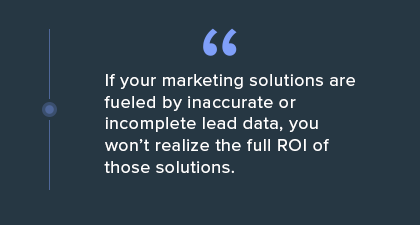You are probably already aware that your company uses a lot of marketing tech stack solutions.
Each solution in your marketing tech stack was chosen to solve a specific problem and deliver a clear ROI. Unfortunately, few marketers realize the full benefit of the tools at their disposal.
Too often, marketers focus on the deployment of a shiny new tool rather than focusing on maximizing the return on the tools they already
For example, a company interested in increasing leads from their website might dedicate a sizeable portion of their marketing budget towards driving traffic from advertising. However, all the traffic in the world means nothing if users don’t convert once they land on the website. Even then, all of the leads in the world have no value if the data isn’t accurate and actionable.
These same principles apply to every solution in your marketing stack. If your marketing stack is fueled by inaccurate or incomplete lead data, you won’t realize the full ROI of those solutions. If marketers make no effort to ensure the integrity of their data from the source, then any time spent “cleaning up” that data is time wasted.
Where Companies Lose ROI in Their Marketing Stacks
Imagine the martech tech stack of a global enterprise, which focuses around technologies that marketers use to execute, analyze and improve their marketing across the customer lifecycle. These may include:
- Eloqua
- Adobe CQ5
- Salesforce.com
- Demandbase
- Tableau
- Data Warehouses
- Google Optimize or Adobe Test

The martech stack is a potent collection of marketing tools. However, like other technology stacks, the martech stack is only as valuable as the integrity and consistency of the data it collects and provides. Here are the common issues marketers run into across the enterprise martech stack when it comes to data integrity and form governance.
Web Form Integration at the CMS Level
At the CMS level, integration with marketing stack (automation) tools like Eloqua isn’t always easy. IT and operations rarely align in terms of priorities and timeline.
For years, the workaround to the latency of integration has been for marketers to build landing pages in Eloqua. However, by doing so, they miss out on the organic traffic to their website and effectively waste part of their investment.
Using a solution that allows you to easily add web forms to your CMS and integrate form data with your marketing automation platform can help increase website traffic while improving UX, conversions and lead quality. Eloqua allows you to create the forms and automatically integrate them into the CMS.
Integrate Demandbase with Conversion Forms
Demandbase is a powerful tool for data enrichment; providing valuable information like business name, industry, company size, etc. Many companies rely on Demandbase for its account-based marketing capabilities, but that isn’t the full potential of all ABM platforms. Top performers also use DemandBase for media targeting and account intelligence, beyond enrichment on forms.
Many marketers fail to integrate Demandbase with conversion forms, thus ignoring the primary benefit of the tool.
Instead, marketers manually feed “messy” data into the Demandbase platform, such as source data that is inaccessible and not preserved in its original form, therefore wasting time and resources. By integrating with a tool like GatedContent.com, all leads are normalized and all data enriched without the need for human data-entry.
Capitalize on Actionable SalesForce & Eloqua Data
Companies that fail to integrate Demandbase with conversion forms are likely to make a similar mistake with their sales enablement and marketing stack automation platforms. Human processing inevitably leads to errors. If the data captured is not normalized it will lead to inaccurate segmentation, and is therefore wasted.
Salespeople hate to waste their time on data that isn’t actionable. Actionable data allows for better lead scoring and lead routing, thus enabling salespeople to close more deals, faster. Quality data also means lead routing is easier to manage and automated thanks to clean account data and customer status information.

Accurate, Sustainable Tableau Reporting
Tableau and similar tools are designed to consolidate data, from a range of sources, but reporting is only as good as the data it collects. Unfortunately, fixing the flaws and deficiencies in the data itself is beyond the limits of the Tableau platform.
GatedContent.com eliminates the issue of “messy” data from the starting gate, which makes producing reports sustainable and contributes to the overall intelligence of the marketing team.
How Can Marketers Ensure Data Integrity?
The first step to ensuring data integrity is recognizing the source of the data hygiene problem – web forms. Managing the consistency of data and the UX of web forms across multiple marketing platforms isn’t easy; however, it is essential, as “messy” data acquisition forms are the primary cause of data inconsistency.
Through web form optimization, the lengthy development cycle to create forms can be simplified by reducing touch points, standardizing templates, and removing the need to include technical development. In turn, the issue of disorganized or missing lead data can be eliminated.
With GatedContent.com, marketers can clean up contact forms, improve their UX, monitor form governance and improve the way they attract and retain customers in the most efficient way possible.
In addition to better marketing insights, accurate lead data enables salespeople to make well-informed decisions and close more deals.
Rather than allocated large amounts of your marketing budget to acquiring new marketing stack tools, work towards gaining the maximum return of investment on your current marketing stack. The first step involves improving your data integrity at the source. GatedContent.com offers a simple, robust solution for better utility, adoption and value of your existing stack. To gain a further understanding of the importance of progressive profiling, take a look at this comprehensive guide.
